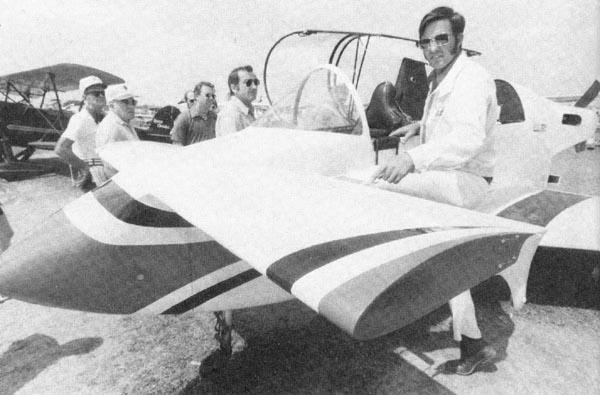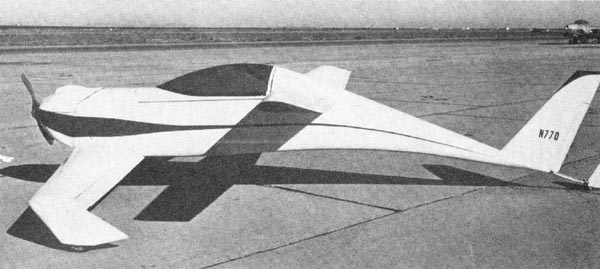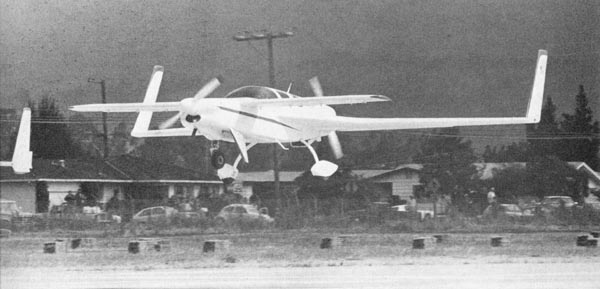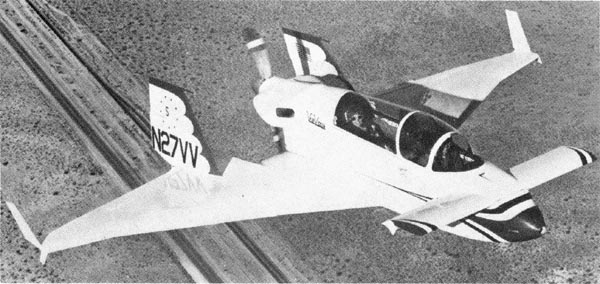Homebuilt Aircraft - February 1981 - 3
- Details
- Category: Magazine Articles
- Published: Friday, 06 March 2009 00:00
- Written by Sam Greene
- Hits: 18099
BURT RUTAN INTERVIEW
The Man from Mojave Talks About Variations On A Quickie Theme
By Sam Greene
 |
| Burt Rutan with the plane that started the canard revolution which has swept homebuilding, the VariViggen. |
There is a kind of poetic justice in the Experimental Aircraft Association’s controversial choice of Viking Aircraft’s beautiful two-place Dragonfly for the Outstanding New Design, 1980, award. “Controversial” because many people have mistakenly identified Dragonfly as a Two-Place Quickie, whereas its designers claim it to be an entirely new concept, with only the full-span canard landing-gear design “borrowed from one of Burt Rutan’s designs.” And “poetic justice” because, since the Dragonfly admittedly is a spinoff from the new technology someone dubbed the Rutan Revolution, the 1980 EAA Award becomes a continuation of tributes to a great guy.
Lest we forget, EAA’s Custom Built Aircraft judges at the 1978 Oshkosh Fly-In chose the Quickie as the Outstanding New Design for 1978. It was the third such award won by the Man From Mojave; in 1974 Rutan’s VariViggen was the winner, followed in 1975 by the Rutan VariEze. No other homebuilt aircraft designer in history has ever held three such awards, so what’s surprising about the Rutan influenced Dragonfly winning top recognition too?
With typical modesty, Rutan felt that the 1980 Outstanding Design Award should have gone to the Glasair, created by Tom Hamilton of lssaquah, Washington, with Dragonfly perhaps winning recognition for excellence in workmanship.
Recently we interviewed Burt on the subject of the Q2/Dragonfly similarities, and he gave this straightforward account:
Rutan: Obviously, Dragonfly uses different construction techniques and has other minor differences. But let’s stick with facts. Dragonfly is a very careful scale-up — in the airfoils, the way the wing is reflexed, in its ratios. They carefully took what we ended up with after a bunch of changes on the Quickie, and then scaled up, although they claim not to have done that.
Q: Regarding the legal aspects: It goes right back to your original design; how does that affect you?
Rutan: I have an agreement with Tom Jewett and Gene Sheehan on Q2; if they make an airplane with the styling of the Quickie, I get a very small royalty on that.
Q: Were you aware of the Q2 or the Dragonfly being built before either was flown?
Rutan: No, I didn’t know about the Dragonfly until after it had flown, about a day before my birthday party last year. And I did not design, test or even fly the Q2. Every week here at Mojave I probably get 10 different guys who say, “Hey, I want to build an eight- place Defiant in my garage,” or a side- by-side VariEze, or make other modifications to it.
Q: How do you evaluate the Q2 and the Dragonfly?
Rutan: As I have not flown either one, my observations would be based only on looking at them and seeing them fly and looking at their specs, though I don’t know whether their specs are true. I do have a pretty good idea of the performance of both planes. I think I know what their weights are, what engines they’re using, what power they’re putting out. So I can talk about performance.
First off, they are not in the same class. Their wing loadings are different. Dragonfly is a bigger airplane with a lot of wing on it, and is at least 100 pounds heavier than the Q2. I personally feel it’s too big an airplane for the engine they’re using, for a two-place, utility craft for high DA flying. We’re aware of that problem, being up here on the Mojave Desert in the hot summer months.
 |
| TOP: Prototype single-place Quickie won Outstanding New Design Award from FAA in 1978, a tribute to Burt Rutan. BOTTOM: Burt Rutan’s RAF-40 Defiant employed a top fuselage shell made in same manner as the new Dragonfly’s top shell. |
 |
Q: How would you compare Q2 and Dragonfly with your original VariEze, N7EZ?
Rutan: The Q2 is closer to my original VariEze, N7EZ, with the VW engine, which was roughly the same weight though a bit lighter than Q2. It also was faster than Q2, but then Q2 is a side-by-side design, and N7EZ was a tandem design. Q2’s wider body makes it slower than VariEze.
I can’t really compare Dragonfly to Q2 directly or to N7EZ directly because Dragonfly has more wing area than my Long-EZ does, yet it has a smaller engine even than Q2. So I think Dragonfly is probably slower on takeoff and landing, with its bigger wing. Up front, it’s simply a bigger airplane than Q2.
Dragonfly unquestionably has much nicer workmanship than any of the homebuilt airplanes that have been prototypes at Oshkosh. The big reason it won the top Design Award was that it looked so beautiful, which should have been a workmanship award criterion.
Q: At the Ramona EAA Fly-In last October, Bob Walters admitted they could use a bigger 1835cc engine for a better climb rate at high DA flying. Any comment?
Rutan: Really? Let me give you my opinion: Dragonfly’s wing area and empty weight are the same as the VariEze . If you took out the VW from Dragonfly and put in an O-200, it would weigh the same as the average VariEze, though heavier than a lightweight VariEze.
The size and weight of their airplane appear to be more appropriately designed around a C85 or an O-200, though I haven’t looked at that carefully — it could make it nose heavy and not balanced right. My point is that the weight and size of the Dragonfly would seem to make it more appropriately designed around the 100-horse engine. I am not inferring that an O-200 should be put in the Dragonfly; I’m just saying that it’s a different category airplane than the Q2.
Q: Burt, how do you evaluate the Q2, not having flown it?
Rutan: Q2 is more apparently designed for high speed cruise, which is what we did with the original VariEze; it belongs more in that class of airplane. It’s got plenty of power in the big 2100-D Revmaster, and they’re now coming close to 180 mph, around 173, I hear. Comparing Q2 with the original VariEze, N7EZ, we were able to go 185 mph at low altitude with the 1835cc engine. But remember, the original VariEze was a smaller airplane so it should have gone faster. The Dragonfly, on the other hand, I guess is about a 150-mph airplane.
Q: You flew your Long-EZ down to Ramona when Dragonfly and Q2 were both there. What was your evaluation then?
Rutan: Well, on Sunday afternoon I flew around the pattern, with Bob Walters in the Dragonfly on my wing. I flew the Long-EZ just above idle, just above the gear horn, and let him stay on my wing. On the last lap, I opened up and left him behind. Dragonfly is a beautiful airplane in the air, and looks like it probably has very good flying qualities.
Remember, both Q2 and Dragonfly seem to be nice airplanes, but they are not in the same class — one is much bigger and, probably because of its wing area, apparently flies like a bigger airplane. It’s not going to have the high-speed performance that Q2 will. On long trips, I’d take the Q2.
Q: At the Ramona Dragonfly seminar, Walters talked about a “new” technique in making compound curves.
Rutan: I have an argument with them concerning their claim that they invented it though they did admit it was an old boat technique. There’s really nothing new about what they’re doing there; we used the same technique on the top shell of Defiant, and boat people have been using it for 15 years. But it is definitely home-build-able; there’s nothing wrong with it.
Q: Then, you feel there’s room in the sky for both the Q2 and the Dragonfly?
Rutan: Yes, I think you’ll find there’s a niche in the market for almost anything a guy can build with acceptable performance and good flying qualities. There’s definitely room for both of them.
Q: Let’s go back to the Quickie design, which I feel was a real breakthrough. . .
Rutan: Please, don’t point to any given thing as a breakthrough. There was a requirement to achieve high miles per gallon and a relatively high cruise speed, in that order. The fixed quantity was an 18-hp engine that weighs 75 pounds, not a very attractive combination, a pretty heavy engine for 18 horses.
With that in mind, our design problem was to make the plane’s systems very simple. This led to the wing/landing gear combination. The Quickie canard/landing gear is only four pounds heavier than it would be as a wing alone. There’s lots of weight and drag savings there.
Quickie is essentially a canard-type aircraft, and the main reason for using the canard was to provide angle of attack limiting, to provide improved stall resistance. All we did basically was take a tandem wing canard type, bend the lower wing into a landing gear to save weight, and then size the wing to provide the appropriate aerodynamic CC between the engine and pilot — a very straightforward evolution, not a breakthrough.
Q: Would you say the Quickie is an extension of the VariEze philosophy?
Rutan: No more so than I’d say the VariEze is an extension of the VariViggen. That wasn’t the only thing we looked for in designing the Quickie. We tried a standard monoplane, a small, single-place VariEze, and a third configuration I don’t want to talk about. What I did was draw up each one and evaluate each separately as to weight, complexity, performance and stability; then I just picked the best one.
Q: Do you see a future in the Quickie design as a multi-place aircraft beyond Q2 and Dragonfly?
Rutan: I think the design would make a better Cessna 172 than a Cessna 172 — a very good short-field airplane if you put enough wing on it, as the Dragonfly shows, and if it had more power. Then it would have very good short-field performance. But when you go to bigger airplanes, deflections are such that putting the wheels at the wingtips is not efficient weightwise or structurally. Also, the plane gets too big for standard taxi-ways. On Quickie, we found that the normal bending of the wing, built strong enough, was just right — about a 6-inch deflection of the gear.
The general wing arrangement on Quickie is the factor that’s different, and it works well. If you compare Quickie to the Beech Staggerwing, it’s very close, except that it has more stagger and no tail, and it gives you the advantage of having a better stall characteristic and less drag.
 |
| Burt Rutan’s original VariViggen was inspired by Swedish SAAB-Viggen fighter that featured canard, delta main wing. |
Q: In designing the VariViggen, were you influenced by the Swedish SAAB Viggen Thunderbolt, with a flapped canard and a main delta wing?
Rutan: Yes, I would certainly admit to that. The SAAB Viggen had not yet flown when the VariViggen was designed, but when I saw the literature on it I immediately began doing some model testing. Remember, too, the canard on the B-70. All I did was make the design work for general aviation.
Q: Why haven’t you patented the Quickie design?
Rutan: Planes like this have been around for a long time — Jack Cox sent me a copy of Popular Mechanics from 1913. There I read about a tandem wing arrangement by an inventor named Drzewiecki, though I hadn’t heard of it when I designed the VariEze.
More important, I think patents are counterproductive; they tend to stand in the way of progress. I feel complimented if people copy my designs. To show what I mean, let me point out that Wilbur and Orville Wright had a lot of fun developing their Kitty Hawk biplane, but once they started moving from the flying arena to the courts, in fighting Glenn Curtiss and others, they made very little progress. They hardly did anything new beyond 1906; they simply failed to keep up with the state of the art.
Q: This brings up the fact that the United States never got a warplane to the Front in World War I. Would you hold the Wright patent fights responsible for that fiasco?
Rutan: You are absolutely right. They held up progress in aviation in this country for a long time, which is why I say patents can be counterproductive!



